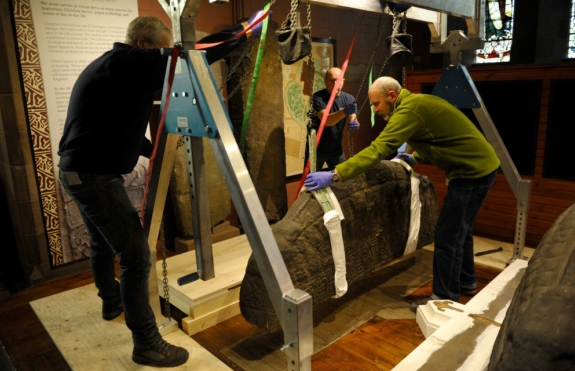Hogbacks are a Viking-period innovation in the sculptural repertoire of Northern England
Viking Hogbacks are a 10th century innovation in the sculptural repertoire in Northern England. . The name of the stone-monuments stem from the curved line of the ridges of the roofs looking a bit like the back of hogs.

However, the stones represents buildings or rather “boat-shaped” houses like those known from 10th century Viking Denmark. It is generally believed that they represent the chieftain’s halls: maybe even “Valhalla”, the mighty hall in Asgaard, where dead Vikings assembled in order to feast together with the Nordic Gods. One of the distinct features of the hog-backs is the end-beasts placed on the gables. These vary a lot. Some are zoomorphic heads, others are massive muzzled animals pawing the ridge of the roof, while others represents the ubiquitous serpents or dragons. However, although some hogbacks are ambiguous in terms of their religious denominations, many of them carry explicit Christian decoration pointing to their “hybrid” character. It is generally believed that the fashion for these tombs reigned no more than 50 years.
Although hogbacks are not found in Scandinavia, they are considered a unique invention made by the Viking settlers in Northern England. Nevertheless they were obviously also inspired by the older Anglo-Saxon tradition for stone-carving; and perhaps inspired by the tradition of keeping “relics” in house-formed cases. However, the styles (Jellinge or Borre-styles) identify the hog-backs as Viking-inspired monuments; something, which also seems to be witnessed by the peculiar distribution within the Viking settlements in Northern Yorkshire and Cumbria. In-depth research into the hogbacks by Dr. Victoria Whitworth is, however, raising some doubt about the usual understanding of these enigmatic stones, which she believes must be seen in a wider context.
Thus, they seem to represent a curious cultural mixture of traditional Anglo-Saxon traditions and design-innovations made amongst the Scandinavian Viking settlers. They are truly “hybrid” monuments with an obscure past, which continue to invite scholarly reflection.
But they are also heavy sand-stones measuring 1 – 1.5 metres and often weighing up to a tonne. Nevertheless, one such hog-back is currently being packed carefully in order to be transported to London for exhibition at the upcoming Viking Exhibition in the British Museum.
This particular hogback stems from a unique collection of 31 Viking-age and Anglo-Saxon stone monuments lying around “unloved” in the Govan Churchyard near Glasgow for more than a thousand years. There used to be 45 stones, but as late as the 1980s some were lost in connection with the demolishment of the neighbouring Harland and Wolff shipyard. They were simply discarded as debris!
The whole collection of Hogbacks can normally be seen at the Parish Museum in Govan, which also exhibits other treasures like the stone sarcophagus believed to have held the relics of St. Constantine, who died in AD 876. The exhibition was recently redisplayed in order to do homage to this unique collection.
READ MORE:
Early Medieval Govan has a dedicated blog
The problem of the Hogback: Lesley Abrams. Paper presented at The Viking Congress 2009. In press
